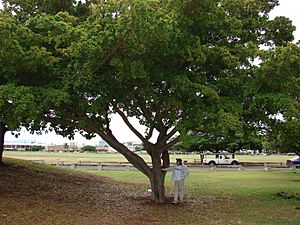Terminalia buceras facts for kids
Quick facts for kids Terminalia buceras |
|
|---|---|
 |
|
| Scientific classification | |
| Genus: |
Terminalia
|
| Species: |
buceras
|
| Synonyms | |
|
|
The Bullet Tree (scientific name: Terminalia buceras) is a type of tree that belongs to the Combretaceae family. It has many common names, like black olive tree, gregorywood, and Antigua whitewood. This tree is originally from Mexico, Central America, the Caribbean, and the northern parts of South America. You can often find it growing in wet areas like coastal swamps and forests at low elevations.
Where the Bullet Tree Grows
This tree is native to the Neotropical realm, which means it naturally grows in tropical parts of the Americas. You can find the Bullet Tree in many countries. These include Colombia, Panama, Costa Rica, and Nicaragua. It also grows in Honduras, Guatemala, and different regions of Mexico.
The Bullet Tree is also common in the Caribbean islands. It grows in the Windward Islands, Leeward Islands, Hispaniola (which includes the Dominican Republic and Haiti), Jamaica, Puerto Rico, Cuba, and the Turks and Caicos Islands. You can also find it in the Bahamas. It has been brought to Florida and Trinidad and Tobago by people.
How the Bullet Tree Grows
The Bullet Tree loves a lot of sunlight to grow well. It prefers soil that is rich, moist, and drains water easily. This tree is very tough! It can handle salty conditions, which is why it often grows near the coast. It is also strong against insects, fungi, strong winds, and even air pollution.
However, its roots are very powerful. They can sometimes lift up paving stones or cause damage to building foundations. This is something to consider when planting it near structures.
Uses of Bullet Tree Wood
The wood from the Bullet Tree is known for being extremely hard and long-lasting. Because it resists insects and fungi so well, people sometimes use it for important building parts. For example, it can be used for house posts or strong timbers in bridges.
The bark of the tree contains something called tannin. This substance can be used to tan leather, which is a process that turns animal hides into leather. The Bullet Tree is also often planted just for its beauty or to provide shade in parks and gardens.
In the past, during the Age of Sail, this strong wood was also used to build ships. For example, the frame of the ship Trelawney Planter, which was built in Jamaica in 1790, was made from Bullet Tree wood.


